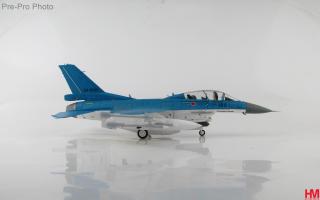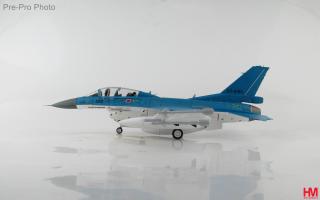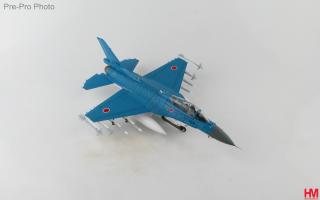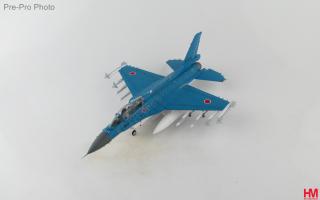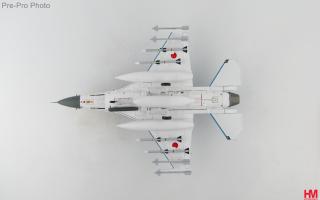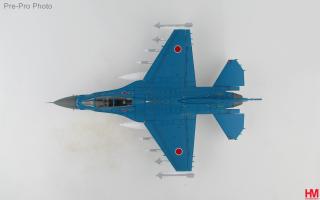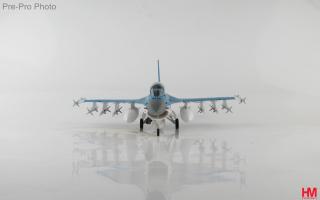Hobby Master Archive
Air Power Jets 1/72
F-2
Japan XF-2B jet Fighter 63-8102, Technical Research and Development Institute & A.D.T.W.
version of the F-16 called the F-16 Agile Falcon. The US military opted not to get the new F-22/JSF. Japan had decided to purchase the F-16 to replace its aging F-1 aircraft but then decided to develop the F-16 Agile Falcon concept. The new aircraft for the JASDF (Japan Air Self Defense Force) would be the F-2 and manufactured with a 60/40 split between Mitsubishi Heavy Industries and Lockheed Martin. Lockheed Martin bought General Dynamics in 1993. Production started in 1996 with the first aircraft being delivered in 2000. 94 of the F-2 aircraft are scheduled to be manufactured. It might look like an F-16 but the Mitsubishi F-2 is a completely new fighter. The general shape may say F-16 and a few things that the F-2 and the F-16 have common are the engine, landing gear, air intake door and the 20 mm gun. But the F-2 has a longer and wider nose to accommodate phased-array radar with 25% larger wing. It is made from a composite material to reduce weight and radar signature, a larger tail plane and larger air intake. The pilot canopy is a stronger three-piece construction. The F-2 is equipped with a drogue chute just like the NATO version of the F-16. The single seat fighter is the F-2A while the two seat version (F-2B) is a trainer that is fully combat capable.
The second prototype of the Mitsubishi XF-2B was 63-0004 and delivered to the Technical Research and Development Institute. In 1996 the designations F2-A was assigned for the single-seat variant and F-2B for the dual-seat. In December of 1997, the serial numbers of all four XF-2 prototypes were changed from the TRDI designations to JASDF system so 63-0004 became 63-8102. 63-8102 was turned over to the JASDF Air Development and Test Wing at Gifu in September 1997. When the F-2B went into production their serial numbers were in the 8100 range.
Specifications Mitsubishi F-2A & F-2B Nickname - Viper Zero Designation F-2A - Single-seat Multi-role fighter F-2B - Two-seat training version, fully combat capable Performance Powerplant: (1) General Electric F110-GE-129 turbofan Dry thrust - 76 kN (17,000 lbf) Thrust with afterburner - 131 kN (29,500 lbf) Maximum speed - Mach 2.0 Range - 520 miles (834 km) on anti-ship mission Service ceiling - 59,000 ft (18,000 m)
Dimensions Length - 50 ft 11 in (15.52 m) Wingspan - 36 ft 6 in (11.13 m) Height - 15 ft 5 in (4.69 m) Wing area - 375 ft² (34.84 m²)
Weights Empty - 21,000 lb (9,527 kg) Loaded - 33,000 lb (15,000 kg) Max takeoff - 48,700 lb (22,100 kg)
Armament (1) 20 mm JM61A1 cannon Capable of carrying up to 17,820 lb (8,085 kg) weapon load on 11 hard points. They are located - #1 and #11 at the wing tips, #2-5 and #7-10 under the wings, and #6 under the fuselage. Possible Weapons Air-to-air - AIM-9 Sidewinder, AIM-7 Sparrow, Mitsubishi AAM-3, Mitsubishi AAM-4 Air-to-ground - ASM-1 and ASM-2 anti-ship missiles. Various free-fall bombs with GCS-1 IIR seeker heads, Mk 82 and JM177 bombs CBU-87, JDAM and JLAU-3/A or RL-4 rocket pods. Others - J/AAQ-2 FLIR Avionics Mitsubishi Active Electronically Scanned Array radar system including J/APG-1. Some differences between the F-2 and the F-16 F-2 has a 25% larger wing area. F-2 is manufactured using composite materials to reduce overall weight and radar signature. F-2 is longer and wider nose to accommodate phased-array radar. F-2 has a larger tail-plane. F-2 has a larger air intake. F-2 has a three-piece cockpit canopy. F-2 is equipped with a drogue parachute.
Hobby Master 1/72 Air Power Series HA2719 Japan XF-2B jet Fighter 63-8102, Technical Research and Development Institute & A.D.T.W. comes with wing pylons and 4 x AAM-3 and 4 x AAM-4
Superb detailing in 1/72 scale. Pre-painted with pad applied markings. Fully assembled. This release has wing pylons 4 x AAM-3 and 4 x AAM-4 Comes with crew figures Display stand included. Option to display model with wheels up or down. Minimum use of plastic.
| Added to archive | 2020-03-14 |
| Last modified | 2020-03-14 |
| Leaflet | 2020-03-01 March 2020 |
